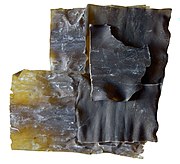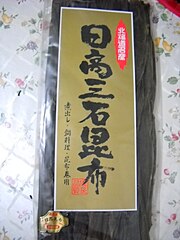Kombu
Kombu , also Konbu ( Japanese 昆布 , kana こ ん ぶ , コ ン ブ konbu , rarely also こ ぶ kobu ), in Korea as Dasima ( Korean 다시마 ) and in China also known as Haidai ( Chinese 海帶 / 海带 , Pinyin hǎidài ), is an edible seaweed , which has found widespread use as a food in Northeast Asia. The vast majority of the kombu comes from the species Saccharina japonica Syn . : Laminaria japonica ( 真 昆布 ma -konbu , German 'Echter Konbu' ).
Over 90% of the Japanese kombu comes from cultivated cultivation, a large part is harvested off the coast of Hokkaidō in very cold water, where the best kombu still comes from today. However, there are also cultures south to the Seto Inland Sea . Even further south the water is too warm.
Kombu has a significantly higher iodine content compared to almost all other foods - and even compared to other edible algae .
history
The earliest records appear in the Shoku Nihongi Imperial Chronicle in 797 as a gift. Wooden tablets ( mokkan ) testify that kombu was delivered under the Ritsuryō legal system by the then Ebisu ( Ezo ) indigenous population in the north (current Tōhoku ) as a tax levy to the court of Nara. However, it is believed that its use goes back much further, probably as far as the Jōmon period . However, since kombu decomposes easily, no more archaeological evidence can be found. In the Muromachi period , a newly developed drying process made it possible to preserve the kombu for more than a few days and the algae became an important commodity from today's region of Tōhoku or the 'wild' Ezo (today Hokkaidō). During this time, the first kombu trading houses and traders' guilds came into being. The latter can be found e.g. B. in the old capital Kyoto still today in the Kombu-ya machi ( 昆布 屋 町 'Kombu-Ladenviertel' ) south of the Imperial Palace, and also many of the trading houses of this time are still active in the Kombu business. B. the Matsumae-ya ( 松 前 屋 ). During the Edo period , when Hokkaido was colonized by the Japanese and shipping lines were organized, the use of kombu spread throughout Japan. Kombu at that time was a tawaramono ( 俵 物 ), d. H. an export product monopolized by the Shogunate (to China) for the purpose of obtaining foreign currency. The economically troubled Principality of Satsuma in particular acted as an organizer to sell kombu from Naha to China via the kombu guild ( 昆布 座 , konbu-za ) . Traditional Okinawan cuisine has made extensive use of kombu since then; Consumption is highest in Okinawa today, although kombu is not naturally found there. Kombu processing hardly changed from 1730 to around 1900. In 1903 there were 45 factories in Osaka, each with 10 to 30 employees, processing kombu. It was not until the 20th century that a method of cultivating kombu, which had previously only been harvested from wild stocks, was found and it became cheap and widely available.
use
There are at least a dozen ways to prepare kombu. Kombu is usually sold in dried form or as dried flakes, also called oboro kombu ( お ぼ ろ 昆布 , 朧 昆布 ).
In Japanese cuisine , kombu is mainly used as one of the three main components of dashi , a soup base. To do this, either a strip of fresh kombu is cooked and served in the soup, or the broth is prepared with powder from dried kombu. A piece of kombu is also added to the cooking water for sushi rice for flavoring. Kombu-tsukudani , kombu cooked in soy sauce, is served as an accompaniment to rice. The consumption of fresh kombu is also possible. The sweet and sour pickling of strips 5–6 cm long and 2 cm wide, which are served as a snack with green tea, is also widespread. Specialties from Osaka are oboro kombu and tororo kombu , which consist of semi-dried and very thinly sliced or sliced kombu marinated in rice vinegar.
In Korean and Chinese cuisines , kombu is added when boiling beans to enrich the food with nutrients and improve digestibility.
In Japan, kombu and other ingredients are also used to make a salty tea, which is called kombucha ( Japanese コ ン ブ チ ャ , 昆布 茶 ) and is a typical health food . What is sold in the West under the name " Kombucha " ( Chinese 紅茶菌 / 红茶菌 , Pinyin hóngchájūn , also 紅茶 菇 / 红茶 菇 , hóngchágū ) has nothing to do with it, does not contain a Kombu and probably got its name through a mix-up receive.
Kombu traded in Germany is provided with a warning, as the high iodine content is problematic for residents of traditional iodine deficiency areas. The Federal Institute for Consumer Health Protection recommends a very controlled consumption of iodine-rich algae such as kombu and their preparations.
More types
In addition to the “real” ma-konbu , other types of Saccharina are also used. The most important are:
- Karafuto -konbu (樺太昆布 , Sachalin -Konbu ' ), Saccharina latissima , also known as the sugar kelp known
- Mitsuishi - (三石昆布 ) Hidaka - (日高昆布 ) or Dashi -konbu (出汁昆布 ) Saccharina angustata commonly used for the fish stock ( dashi ,出汁 ) in Japanese cuisine used
- Naga-konbu ( 長 昆布 , German about "Langes-Konbu"), Saccharina longissima
- Rishiri -konbu (利 尻 昆布 ), Saccharina ochotensis , commonly used for broth.
photos
- Konbu - recovery
Konbu drying, Wakkanai 2018
Drying of Rishiri-Konbu, Rishiri Island 2006
Konbu in the department store, Kagoshima 2011
Konbu in Chinese cuisine, London 2011
- annotation
See also
Web links
- Kombu Seaweed Encyclopedia (English)
Individual evidence
- ^ Term Kombu, Konbu - 昆布. In: tangorin.com. Retrieved May 17, 2019 (English, Japanese).
- ^ Term Konbu - 昆布. In: Wadoku . Retrieved May 17, 2019 (German, Japanese).
- ^ Term Konbu - 昆布. In: www.zdic.net. Retrieved May 17, 2019 (Chinese, English).
- ^ Term Konbu - 昆布. In: dict.revised.moe.edu.tw. Retrieved May 17, 2019 (Chinese).
- ↑ term Haidai -海帶/海带. In: www.zdic.net. Retrieved May 17, 2019 (Chinese, English).
- ↑ term Haidai -海帶/海带. In: leo.org . Retrieved May 17, 2019 (Chinese, German).
- ↑ term Haidai -海帶/海带. In: dict.revised.moe.edu.tw. Retrieved May 17, 2019 (Chinese).
- ↑ a b Dried seaweed and dried algae leaves with excessive iodine levels. (PDF; 44 kB) In: Federal Office for Consumer Protection and Food Safety (BVL). Retrieved August 27, 2019 .
- ^ Wilhelm, Johannes Harumi (2001): Resource management in Japanese coastal fishing . Master's thesis: University of Bonn pp. 20 and 44-47
- ↑ Habara, Yūkichi 羽 原 又 吉 (1940): 日本 昆布 業 資本主義 史: 支那 輸出 Shina yushutsu nihon kobugyo shihonshugi-shi - "The Export of Kombu to China as a History of Capitalism". Tōkyō: Yūhikaku.
- ↑ Ōishi, Keiichi 大石 圭一 (1987): 昆布 の 道 Konbu no michi - "The way of the Konbus". Daiichi shobo.
- ^ Hugh M. Smith: The Seaweed Industries of Japan . In: Bulletin of the Bureau of Fisheries . tape 24 , 1905, pp. 146 (English, noaa.gov [PDF; 4.5 MB ]).
- ↑ Ole G. Mouritsen, Prannie Rhatigan, José Lucas Pérez-Lloréns: World cuisine of seaweeds: Science meets gastronomy . In: International Journal of Gastronomy and Food Science . tape 14 , 2018, p. 56 , doi : 10.1016 / j.ijgfs.2018.09.002 (English).







